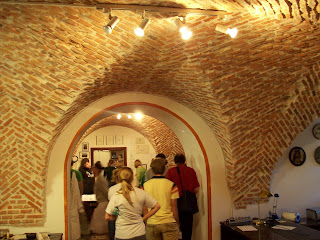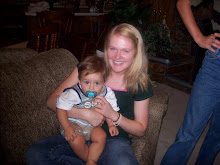 Some pictures from the Resoration. Specifically of my favorite spiral staircase to the choir loft. Basically, several decades ago, this architect, Hildebrand, discovered Kartause Maria Thron. At the time, it was in shambles, overgrown, rundown and falling into ruins. He made it his life-time hobby to restore it. Of course he worked as an architect, so he could only work on the weekends, and he rested on sunday. That made for slow progress.
Some pictures from the Resoration. Specifically of my favorite spiral staircase to the choir loft. Basically, several decades ago, this architect, Hildebrand, discovered Kartause Maria Thron. At the time, it was in shambles, overgrown, rundown and falling into ruins. He made it his life-time hobby to restore it. Of course he worked as an architect, so he could only work on the weekends, and he rested on sunday. That made for slow progress.It was also confusing on just how to restore it...Should he restore it entirely back to it's original 1342 gothic self, or leave some of the renaissance and baroque restorations? The ceiling, for instance, is a gothic ceiling with a baroque ceiling re-made about 400 years later twenty feet below it. That he just repaired and left with a double ceiling. But the side Eucharistic chapel displays the original gothic arches. The frescoes to left and right of the main altar, depicting Faith, hope and Love were under seven layers of plaster. Can you imagine the trembling hand he laid to each one, wondering whether he is about to ruin something?
Hildebrand was a funny man. He cracked jokes throughout our whole tour and really just endeared himself to us all. He made professor Herrera translate for him, but sometimes he would take over and speak near perfect english anyway.

 The "secret garden"
The "secret garden"

 This was the home of Johanna, wife of Albrecht II, in Burgundy. Albrecht modeled his Maria Thron after her chapel to ease her homesickness.
This was the home of Johanna, wife of Albrecht II, in Burgundy. Albrecht modeled his Maria Thron after her chapel to ease her homesickness.It is said that Johanna was the one who sat for the sculpture of the Maria Thron in the chapel. That and the two figures in the chapel (copies of the originals in St. Stephen's in Vienna) are the only likenesses of Johanna in existence today.
Another interesting thing: it was from here that Albrecht II made Vienna a city. We have a copy of the township license proclamation thingy, in Hebrew, German and Latin I think, saying that the Emporer intended to make that area of the country his imperial palace.
 Ooh la la. Siloutted (humility) roses (Mary/love/sacrifice), Red (humanity) tile roof, Blue (divinity) sky, white (purity) walls. Is there not something very Maria Thron about that?
Ooh la la. Siloutted (humility) roses (Mary/love/sacrifice), Red (humanity) tile roof, Blue (divinity) sky, white (purity) walls. Is there not something very Maria Thron about that? Hildebrand made us try guessing what this was. He said he found it in the treasury. It was an early tomb of some Roman child. He made it into a fountain.
Hildebrand made us try guessing what this was. He said he found it in the treasury. It was an early tomb of some Roman child. He made it into a fountain.

 These I think, were archery targets...although I doubt if that was their orignial intention. I forgot to ask Hildebrand.
These I think, were archery targets...although I doubt if that was their orignial intention. I forgot to ask Hildebrand.



 A cool room. I hit my head on one of the gothic arches shortly after this picture and I have a huge goosegg to show for it. I was afraid I damaged the thing at first, I hit it so hard. I almost fell over...luckily only one guy was watching, the ITI student in the yellow shirt, whom I like because he reminds me of someone, so I forgave him for seeing my blonde blunder.
A cool room. I hit my head on one of the gothic arches shortly after this picture and I have a huge goosegg to show for it. I was afraid I damaged the thing at first, I hit it so hard. I almost fell over...luckily only one guy was watching, the ITI student in the yellow shirt, whom I like because he reminds me of someone, so I forgave him for seeing my blonde blunder.
 This courtyard was seen by no one but the monks for 400 years: 1342-1742, when Josef II closed many many monasteries in Austria because they had too much power. The windows, amazingly enough, including the one in my room, survived the centuries and most are original from the 14th century! Just thinking about all the different people who have been in my room is amazing. I mean, this is probably where the servants Albrecht II lived, and then farmers, then during the Soviet invasion and WWII Russian soldiers slept here, keeping their horses in the chapel.
This courtyard was seen by no one but the monks for 400 years: 1342-1742, when Josef II closed many many monasteries in Austria because they had too much power. The windows, amazingly enough, including the one in my room, survived the centuries and most are original from the 14th century! Just thinking about all the different people who have been in my room is amazing. I mean, this is probably where the servants Albrecht II lived, and then farmers, then during the Soviet invasion and WWII Russian soldiers slept here, keeping their horses in the chapel.The monks were pretty amazing. They never slept more than 3 hours at a time. They kept a perpetual vow of silence, besides communal prayer, except for 4 hours on Sundays. Hildebrand said they didn't have much to talk about even then, so they just prayed the rosary together. They were vegetarians, to which some attribute their longevity. Apparently many people of the time died of food poisoning from meat.
One monk lived to be 115 years old. He even then didn't die of old age, but died after being thrown from a horse while returning from delivering a message to Salzburg!
 Pointing to landmarks in Europe are.
Pointing to landmarks in Europe are. The Biblioteke. At the end, it was just Hildebrand, and about 20 other students lingering. He took us through a door just under the flags. It was his own living room. He showed us all through his AWESOME hidden house. It was so sweet. He told us not to tell the other students because they would get jealous.
The Biblioteke. At the end, it was just Hildebrand, and about 20 other students lingering. He took us through a door just under the flags. It was his own living room. He showed us all through his AWESOME hidden house. It was so sweet. He told us not to tell the other students because they would get jealous.



 An oil painting in Hildebrand's living room of the Kartause in its full splendor, probably about 450 years ago. I live in the building in the far right middle. The half to the right of the Maria Thron Chapel is what Emporer Albrehct II built for himself and his court. The left half was for the monks.
An oil painting in Hildebrand's living room of the Kartause in its full splendor, probably about 450 years ago. I live in the building in the far right middle. The half to the right of the Maria Thron Chapel is what Emporer Albrehct II built for himself and his court. The left half was for the monks. Half of the wall still remains. It is a good wall...witheld a turkish seige that lasted only a day before they gave up and went away.
He was the first ruler in the world to have this idea of living in a humble palace attatched to a monastery. Alrecht was born in Hungary and moved to Austria after marrying a princess of Burgundy, Johanna. Together they had 7 children. The whole family is buried in the floor of the Maria Thron. Every five years anthropologists are allowed to open the tomb and study the remains and treasures. I asked Hildebrand when they will open it again, and he smiled with a twinkle in his eye. "It has been five years. "
 This corner fresco depicted Europe
This corner fresco depicted Europe Rotundae are impossible to photograph. Even laying on the floor, this is the type of picture you get. This is in the Biblioteke (secret library). It shows the Seven Liberal Arts.
Rotundae are impossible to photograph. Even laying on the floor, this is the type of picture you get. This is in the Biblioteke (secret library). It shows the Seven Liberal Arts. This is the 4 evangelists. If you can make it out, look at the corner just left of the window. There is an easel and madonna sketch, randomly thrown in the fresco. The story goes the artist, whose name escapes me at the moment, finished his work early that day, had extra paint to use, and so decided to have a little fun!
This is the 4 evangelists. If you can make it out, look at the corner just left of the window. There is an easel and madonna sketch, randomly thrown in the fresco. The story goes the artist, whose name escapes me at the moment, finished his work early that day, had extra paint to use, and so decided to have a little fun! There are other places where the painter's sense of humor shows as well. Several places the paintings are 3-D in plaster. A dragon's tail comes out from the wall in one spot, part of a Greek's cloak, an eagle's beak and a lion's face jump out from the flat wall.
 These corner frescoes depict the corners of the world: The Americas above and Asia below
These corner frescoes depict the corners of the world: The Americas above and Asia below


 This is the corner fresco for Africa
This is the corner fresco for Africa
 The back of Hildebrand's hidden house.
The back of Hildebrand's hidden house.
 This was Hildebrand's office room. It used to be a pig sty. Literally.
This was Hildebrand's office room. It used to be a pig sty. Literally.
 These corner frescoes depict the corners of the world: The Americas above and Asia below
These corner frescoes depict the corners of the world: The Americas above and Asia below

 This is the corner fresco for Africa
This is the corner fresco for Africa The back of Hildebrand's hidden house.
The back of Hildebrand's hidden house. This was Hildebrand's office room. It used to be a pig sty. Literally.
This was Hildebrand's office room. It used to be a pig sty. Literally. 


1 comment:
So, if Hilderbrand told you not to tell any of the other students that he showed the 20 of you his house because they would get jealous, why did you post it on your blog? ;) "Oh, okay, yea Hilderbrand. I will not tell any of the other students. But, HEY WORLD! I have a secret!" Hehe...you know I have to give you a hard time, right?
Post a Comment